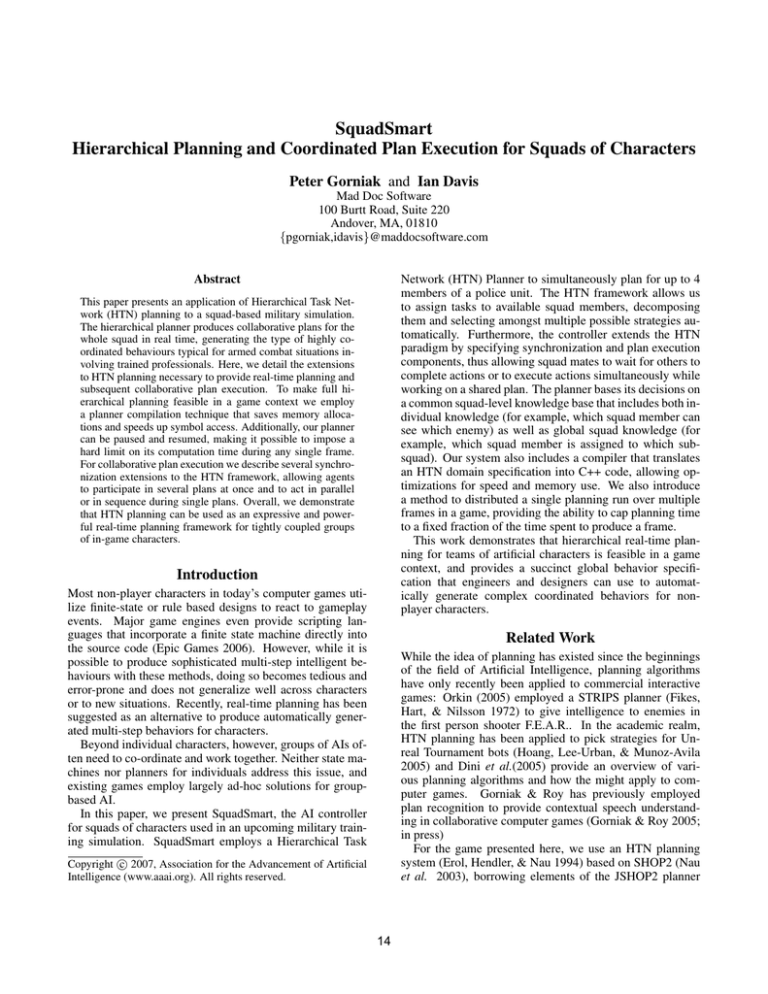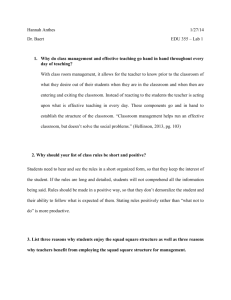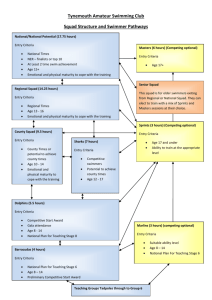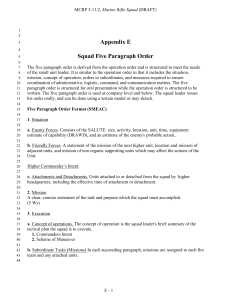
SquadSmart
Hierarchical Planning and Coordinated Plan Execution for Squads of Characters
Peter Gorniak and Ian Davis
Mad Doc Software
100 Burtt Road, Suite 220
Andover, MA, 01810
{pgorniak,idavis}@maddocsoftware.com
Abstract
Network (HTN) Planner to simultaneously plan for up to 4
members of a police unit. The HTN framework allows us
to assign tasks to available squad members, decomposing
them and selecting amongst multiple possible strategies automatically. Furthermore, the controller extends the HTN
paradigm by specifying synchronization and plan execution
components, thus allowing squad mates to wait for others to
complete actions or to execute actions simultaneously while
working on a shared plan. The planner bases its decisions on
a common squad-level knowledge base that includes both individual knowledge (for example, which squad member can
see which enemy) as well as global squad knowledge (for
example, which squad member is assigned to which subsquad). Our system also includes a compiler that translates
an HTN domain specification into C++ code, allowing optimizations for speed and memory use. We also introduce
a method to distributed a single planning run over multiple
frames in a game, providing the ability to cap planning time
to a fixed fraction of the time spent to produce a frame.
This work demonstrates that hierarchical real-time planning for teams of artificial characters is feasible in a game
context, and provides a succinct global behavior specification that engineers and designers can use to automatically generate complex coordinated behaviors for nonplayer characters.
This paper presents an application of Hierarchical Task Network (HTN) planning to a squad-based military simulation.
The hierarchical planner produces collaborative plans for the
whole squad in real time, generating the type of highly coordinated behaviours typical for armed combat situations involving trained professionals. Here, we detail the extensions
to HTN planning necessary to provide real-time planning and
subsequent collaborative plan execution. To make full hierarchical planning feasible in a game context we employ
a planner compilation technique that saves memory allocations and speeds up symbol access. Additionally, our planner
can be paused and resumed, making it possible to impose a
hard limit on its computation time during any single frame.
For collaborative plan execution we describe several synchronization extensions to the HTN framework, allowing agents
to participate in several plans at once and to act in parallel
or in sequence during single plans. Overall, we demonstrate
that HTN planning can be used as an expressive and powerful real-time planning framework for tightly coupled groups
of in-game characters.
Introduction
Most non-player characters in today’s computer games utilize finite-state or rule based designs to react to gameplay
events. Major game engines even provide scripting languages that incorporate a finite state machine directly into
the source code (Epic Games 2006). However, while it is
possible to produce sophisticated multi-step intelligent behaviours with these methods, doing so becomes tedious and
error-prone and does not generalize well across characters
or to new situations. Recently, real-time planning has been
suggested as an alternative to produce automatically generated multi-step behaviors for characters.
Beyond individual characters, however, groups of AIs often need to co-ordinate and work together. Neither state machines nor planners for individuals address this issue, and
existing games employ largely ad-hoc solutions for groupbased AI.
In this paper, we present SquadSmart, the AI controller
for squads of characters used in an upcoming military training simulation. SquadSmart employs a Hierarchical Task
Related Work
While the idea of planning has existed since the beginnings
of the field of Artificial Intelligence, planning algorithms
have only recently been applied to commercial interactive
games: Orkin (2005) employed a STRIPS planner (Fikes,
Hart, & Nilsson 1972) to give intelligence to enemies in
the first person shooter F.E.A.R.. In the academic realm,
HTN planning has been applied to pick strategies for Unreal Tournament bots (Hoang, Lee-Urban, & Munoz-Avila
2005) and Dini et al.(2005) provide an overview of various planning algorithms and how the might apply to computer games. Gorniak & Roy has previously employed
plan recognition to provide contextual speech understanding in collaborative computer games (Gorniak & Roy 2005;
in press)
For the game presented here, we use an HTN planning
system (Erol, Hendler, & Nau 1994) based on SHOP2 (Nau
et al. 2003), borrowing elements of the JSHOP2 planner
c 2007, Association for the Advancement of Artificial
Copyright Intelligence (www.aaai.org). All rights reserved.
14
HTN Planning Applied to Squads
compilation techniques (Ilghami & Nau 2003). The broader
context of collaborative plans of which those discussed here
are a subtype is discussed by Grosz & Kraus 1996.
During the game, a sensory system deposits knowledge into
the HTN state representation. For example, squad members see enemies and doors, and can tell whether enemies
are surrendered, restrained or dead. By default, the game
runs the planner at fixed time intervals. Squad members can
be part of any number of plans simultaneously, the only restriction being that they cannot perform two plan steps at
the same time. Certain events can also force an immediate re-planning, such as a squad member dying. The planner’s domain has a single top-level task with an associated
method that prioritizes all possible sub-tasks. The planner
will always select the first accomplishable method branch,
and, adopting the SHOP semantics, it will in fact fail to find
a plan if a method branch’s precondition is fulfilled but the
branch itself fails.)
Figure 1 shows the specification for the HTN methods accomplishing the restraining of surrendered suspects by squad team members. The general method
squad restrain finds the closest squad member to a restrained target. The helper method first attempts to find a
second squad member close by that can perform a complement to the restrain (covering the event with raised weapon),
or has the closest squad member perform the restrain alone
if no suitable partner can be found. Most of the predicates
directly match knowledge deposited in the state by the sensory system. Some are proven via axioms, for example
different. The call term calls an external or a library function, here MDActorDistance to measure the
distance between the squad member and the suspect to be
restrain, and < to decide whether the squad member is close
enough to the suspect to perform an autonomous restrain.
The assign term assigned the result of an expression to a
variable (here ?d for distance) where the :sort-by clause
enforces the bindings for the following precondition to be
sorted by the given variable’s value, here again distance.
In this simple example, the helper method directly expands into primitive tasks, accomplished by operators. As
in SHOP, we distinguish between internal (marked by “!!”)
and external (marked by “!”) operators. Internal operators always have their effects applied and do not engage
squad members in action, whereas external operators cause
the squad member to perform an action on the game world,
which may result in the state of knowledge changing. For
example, restraining a suspect will cause the sensory system
to add a restrained fact about that suspect to the world
state. The !!reserve operator checks that its argument
is not already marked as reserved and then marks it as
reserved. This prevents a subsequent planning run from reserving the same target for a different purpose (or for the
same purpose repeatedly.)
Figure 2 shows the domain graph for the squad planner.
Decomposition of methods into other methods and operators
is shown via arrows.
Hierarchical Planning for Squads
We follow the SHOP (Simple Hierarchical Ordered Planner) in our domain specification and implementation, which
means our planner plans for tasks in the same order that
they will be accomplished. Similar to the SHOP planner,
our planner supports various symbolic and numeric computations as well as external function calls.
HTN Planning
A task in HTN planning can be either compound or primitive
in nature. Compound tasks decompose into further tasks,
whereas primitive tasks, the leaves of the task network, can
be directly executed. The planning domain consists of methods, which specify how to decompose compound tasks, operators which accomplish primitive tasks and axioms, which
prove logical primitives without accomplishing tasks. Each
method can have several branches, and there can be several
operators for the same task, providing multiple ways of accomplishing a task. Each method branch and each operator
has a precondition dictating whether it applies to the current
state of the world or not. Only operators actually change
the state of the world by adding to or deleting from it. The
final plan is a linear sequence of such operators that accomplishes a given task, if such a sequence exists. The planner
performs a search by decomposing tasks using the domain’s
methods and operators, gathering valid bindings for logical
expressions as it proceeds.
As one of our goals in the design of SquadSmart was to
provide a centralized and general planning mechanism and
domain, we chose to use SHOP’s general logical expression
language instead of incorporating the logic of planning into
game-specific C++ code. While this does mean that time and
memory is spent on general logical proofs and the accompanying bookkeeping, it allows us to cleanly separate the domain specification and the planner from the game code itself,
and to make SquadSmart re-useable for other game types.
We address the performance issues via domain compilation
and interruptible planning as discussed below.
The state of the world is specified as a collection of logical predicates denoted as (p t1 t2 ... tn ) where p is the head
of the predicate and the t1 ... tn are constants or numbers.
Operators and methods, marked with the :operator and
:method tags respectively, each contain a head, which is a
predicate as above which can also contain variables as terms
(denoted with a question mark as in ?x). An operator also
specifies a precondition (a logical expression which is evaluated using the current variable bindings and the current state)
as well as an add and a delete list of ground predicates that
will be added to or deleted from the world state when the
operator is applied. A method consists of method branches,
each branch in turn constituted by a precondition as well as
a list of tasks into which this branch decomposes the parent
task. We provide examples of planning domains in the next
section.
Planning Efficiency and Time-Slicing
Planning in general and HTN planning in particular is usually implemented as a recursive search process generating
15
(:method (squad_restrain_helper ?squad ?target)
;;-- PRECONDITION
;;restrain with complement
;;use second closest squad member to target
(:sort-by ?d ((squadmember ?squad2)
;;make sure it’s a different squad member than the one
;;performing the restrain
(different ?squad ?squad2)
;;make sure the squad member isn’t under other orders
(not (following_order ?squad2))
;;measure the distance to the retrain target
(assign ?d (call MDActorDistance ?squad2 ?target))
;;don’t perform a complement if too far away
(call < ?d 400)))
;;-- TASK DECOMPOSITION
(;;reserve all parties involved
(!!reserve ?squad) (!!reserve ?squad2) (!!reserve ?target)
;;perform the restrain
(!restrain ?squad ?target)
;;in parallel, perform the complement
(!restrain_complement ?squad2 ?target)
;;at this point, do not go further until restrain is done
(!!global_block ?squad)
;;free all parties involved
(!!free ?squad) (!!free ?squad2) (!!free ?target))
-- SECOND BRANCH (if first one’s precondition fails)
;;lonely restrain
-- PRECONDITION
() ;;all precondition elements for this case are covered in the parent
-- TASK DECOMPOSITIOIN
(;;reserve all parties involved
(!!reserve ?squad) (!!reserve ?target)
;;perform the restrain
(!restrain ?squad ?target)
;;wait till the restrain is done (so we don’t free the target prematurely)
(!!global_block ?squad)
;;free everyone
(!!free ?squad) (!!free ?target)))
(:method (squad_restrain)
;;-- PRECONDITION
;;use closest squad member to target
(:sort-by ?d (;;find a surrendered target
(surrendered ?target)
;;that’s also an enemy
(enemy ?target)
;;pick a squad member
(squadmember ?squad)
;;make sure the target is alive
(not (dead ?target))
;;measure distance between squad member and target
(assign ?d (call MDActorDistance ?squad ?target))
;;do not autonomously restrain if too far away
(call < ?d 400)))
;;-- TASK DECOMPOSITION
;;we now know this is a valid restrain situation
;;the helper will decide whether to perform a complement or not
((squad_restrain_helper ?squad ?target)))
Figure 1: SHOP code of HTN methods for autonomous restraining
16
start
cleanup_dead
start_orders_clear
!!cleanup_dead
handle_orders_clear
team_restrain
team_poke_dead
poke_dead_helper
!!finish_action
!poke
clear_callout
all_team_at_tactical
!bandage_self
restrain_helper
!!global_block !restrain
!cover_target
bandage
!!take_control !goto_combat
team_combat
team_advance
squad_clear
!open_combat !!reserve
use_cover
maybe_callout
arrive
squad_advance
!!free !use_cover !clear_callout arrive_point
!restrain_complement !cover_combat
end_orders_clear
cancel_order
giveup_control
!!free_targets
!!cleanup_all !!cancel_plans
!!giveup_control
!arrive_point play_advancing_vo
!!block_on
!play_vo
!goto
!idle
Figure 2: Relationships between Domain Methods, External and Internal Operators for the Squad Domain
possible plans. As such, it is hard to predict or limit how
long any given planning search will take, especially in a setting where the world changes as dynamically as in a realtime game. One way to make planners more efficient is to
make them highly specific to the planning problem in question. Orkin, for example, limits the planner in F.E.A.R. to
only consider a small static array of typed variables that
specify a world state only applicable to this particular game.
However, doing so limits the generalizability of the planner it needs to be heavily revised to function in another game and
actual game data structures have to change if the scope of
the world state changes during development. Furthermore,
the knowledge and rules of the planner are embedded in the
game’s C++ code, making it harder to keep them modular
and general.
A full logic representation for both planning domain and
world state, on the other hand, implies a level of abstraction
and indirection that sacrifices some efficiency in favour of
gaining expressive power, generality and a clean separation
from other game code. It also allows us to enforce a centralized knowledge representation that the planner works from,
ensuring that when any given decision is made in the game
we have easy access to the full state of knowledge that the
decision was based upon.
To eliminate the problem of efficiency introduced by our
decision, we adopt two strategies: domain compilation and
time slicing of the planning process. Domain compilation is
part of a planner compilation technique recently introduced
for the JSHOP planner (Ilghami & Nau 2003), which compiles both the domain and the problem into a unique instance
of the planner that solves exactly the one problem specified.
Our problem and state are highly dynamic making it impossible to compile them into C++ code beforehand, but the
domain is static and can be optimized during compilation.
Introducing domain compilation lets us turn dynamic arrays
into static, fixed-size arrays, allows us to replace arbitrary
names for variables and predicates with C++ enumerations
and makes it possible to pre-allocate most structures needed
at the beginning of the game to avoid memory fragmentation and allocation overhead during planning. Note that the
compilation technique is independent of the game itself, and
can thus be re-used for other domains and games.
Domain compilation goes a long way towards making any
single planning step more efficient, but it does not prevent
deeps recursion during the generation of complex plans. If
such a long planning session is performed during a single
frame it produces a computation time spike for that frame,
which is unacceptable in a game. To eliminate this problem, we have implemented time-slicing for our HTN planner, which allows us to pause the planning process at any
given time, and resume it later. In this way, planning can
be spread out over multiple frames, and we can guarantee
that the planner never take more than its allocated time per
frame, while still finishing planning in few enough frames
to make characters responsible to game events. To be able
to pause planning at any given time, we produce all logical
bindings through generators that produce one binding at a
time, eliminating recursion to produce nested bindings. In
addition, our outer planning loop that drives the search process by recursively looking for the appropriate methods and
operators to solve the current problem saves its stack. Each
stack frame consists of
1. the current method or operator being tried
2. in the case of a method, the method branch being tried
3. the generator for the current operator or method branch’s
17
precondition
plan reserve the target when the current plan has reserved
the squad member.
4. the current list of tasks being solved
5. a flag indicating whether a satisfier has been found for
the current method branch (no further branches should be
tried from this method if this flag is true).
Synchronization Facilities
According to the plan execution semantics covered so far,
actions by different actors are always carried out in parallel,
and general plan execution always proceeds despite a given
character carrying out an action. Interpreting plans in this
way allows the parallelism necessary for team action, but
does not provide a way for one actor to wait for another, or
for plan execution to halt until an actor finishes its action. To
support such synchronization, we introduce several special
internal operators:
Once the planner has exceeded its allocated time during
a given frame it begins unwinding its current recursion. On
the next frame, it continues planning by re-using the saved
stack frames at each level of recursion, arriving back at the
place it left the search.
Plan Execution
!!block on Takes two actors as arguments, and marks
the first as busy until the second finishes the current action.
Standard HTN planning specifies little about plan execution
beyond the notion that primitive tasks can be carried out by
some agent in the sequence specified by the plan. SHOP
adds the distinction between internal and external operators,
but stops there. In the scenario discussed here, however,
real-time execution of plans involving several characters requires both the specification of execution semantics such as
blocking on actions and synchronization as well as the handling of action failures and character deaths.
!!global block Waits with any further execution of the
plan it appears in until the actor specified as its argument
finishes its current action. Other plans continue executing.
!!finish action Forcefully finishes an actors current
action rather than waiting for it to finish normally.
The example in Figure 1 shows a use of !!block on:
the three !!free operators are only executed once the actor bound to ?squad finishes the !restrain action. If
this operator was left out, the target would be freed immediately, the first squad member freed when the restrain finishes, and the second freed when the complement finishes.
The !!block on operator is especially useful for making
one squad member wait for another, for example to wait for
a command voice over to finish before acting on the order.
Finally, !!finish action allows interruption of actions
that do not finish (guarding a suspect is such an action in our
game).
Execution Semantics
In-game actions may take some time. Executing an action
can thus mark the squad member as busy. We assume that
squad members can be busy with exactly one action at any
given time. However, some actions may not mark squad
members as busy despite taking time to execute. For example, voice overs may play while other actions are executed.
Whether to mark a squad member as busy can also be parameterized - voice overs in some plans should play during
other actions, while other may require waiting for voice over
completion (e.g. squad member should only start advancing
once the “area clear” has completed.)
When a squad member is marked as busy, all further actions involving this squad member are blocked, including actions that would not mark the squad member as busy. In the
restrain method above, for example, the !!free operator on ?squad will only execute once the squad member
bound to the variable has finished its !restrain action.
Actions involving other actors, however, can freely execute,
such that in the example above the second squad member
performs its !restrain complement while the first is
performing its !restrain. The planner continuously produces plans during plan execution so that squad members
can be involved in several plans at any given time.
If an action does not mark a squad member as busy, it is
executed and plan execution proceeds to the next action in
the plan. The execution loop guarantees that all such actions
are executed immediately, meaning before the world state
changes or other actions finish or new plans are produced.
Thus, if a plan is found consisting only of actions that do
not engage actors, it executed completely in the same frame,
not interleaving with any other plans. Guaranteeing immediate execution for these actions provides atomicity for operator groups such as the double !!reserve in the restraining
example, making sure that it is not possible to have another
World State Updating
As we already mentioned above, the updating of the world
state that planning is based on is more complicated during
plan execution that it is during planning. During planning,
all operator effects are immediate and their effects are completely specified by the operator description. During execution, however, some operators take time to execute, and
they may fail to achieve their effects, and some of their effects may be internal to the planning system while others are
based on sensing the game world. We therefore introduce a
three-way distinction amongst the effects of external operators: The predicates they change can be marked to change
when the operator starts executing, when the operator stops
executing, or as external to plan execution. For example,
when the !restrain operator begins executing it adds
a predicate (restraining ?squad ?target) to the
world state, which can be used by other plans or the restrain
complementer to find the current restrainer. When the action
finishes, the operator removes this predicate again. During
planning this operator also adds a predicate (restrained
?target) to the world state to signal the effect of its application. During execution, however, it does not. Rather, the
sensory system will start perceiving the target as restrained
18
once the restrain completes, and add the same predicate. If
the restrain fails (say, because enemies appear that should be
fought first), the predicate will not be added and the planner
may find a similar plan again to perform the restrain.
ing games. In Proceedings of Artificial Intelligence and
Digital Entertainment.
Gorniak, P., and Roy, D. in press. Situated language understanding as filtering perceived affordances. Cognitive
Science.
Grosz, B., and Kraus, S. 1996. Collaborative plans for
complex group action. Artificial Intelligence 86(2):269–
357.
Hoang, H.; Lee-Urban, S.; and Munoz-Avila, H. 2005. Hierarchical plan representations for encoding strategic game
ai. In Proceedings of the conference for Artificial Intelligence in Digitial Entertainment.
Ilghami, O., and Nau, D. 2003. A general approach to synthesize problem-specific planners. Technical report, University of Maryland. CS-TR-4597, UMIACS-TR-2004-40.
Nau, D.; Au, T.; Ilghami, O.; Kuter, U.; Murdock, W.; and
Wu, D. 2003. Shop2: An HTN planning system. Journal
of Artificial Intelligence Research.
Orkin, J. 2005. Agent architecture considerations for realtime planning in games. In Proceedings of the conference
for Artificial Intelligence in Digitial Entertainment.
Squad Behaviors
As sketched in Figure 2 we have used the HTN squad planning and execution system described here to implement several complex team behaviours in a game. Squad members
pair up to perform autonomous restraining of suspects as
well as investigative actions. When ordered to clear a room,
they proceed in pairs, alternatingly advancing once an area is
announced as clear, bandaging as needed, calling out doors
as they proceed and fighting potential hostiles before continuing. The logic gracefully handles the death of squad members, allowing asymmetric clear behaviours to continue until
complete.
Conclusion and Future Work
We have shown an application of HTN planning to generating the behaviours of small teams in computer games. While
the plain HTN framework provides a good basis, we have
discussed that it is necessary to perform compile-time optimization of the planner as well as timeslicing to achieve
suitable performance for a modern real-time video game.
Most importantly, however, we have detailed an execution
framework for HTN plans that handles plans for several actors, addressing issues of parallelism, synchronization and
time-sensitivity as well as sensed operator effects.
While our framework currently handles failed plans in
limited cases, such as the case described above where a battle interrupts a restrain plan, it does not handle general operator or sub-plan failure. The first step to adding plan failure
handling would be to collect the preconditions for a given
step from the whole plan tree, and to check before the step
is executed that the preconditions still hold. If they do not, or
if the action fails for another reason, the system can re-plan.
More graceful failure modes may also be possible, such as
re-planning only for failed subtrees. We intend to add this
functionality in the near future.
References
Dini, D. M.; van Lent, M.; Carpenter, P.; and Iyer, K. 2005.
Building robust planning and execution systesm for virtual
worlds. In Proceedings of the conference for Artificial Intelligence in Digitial Entertainment.
Epic Games.
2006.
Unreal engine 3.
http:
//www.unrealtechnology.com/html/
technology/ue30.shtml.
Erol, K.; Hendler, J.; and Nau, D. 1994. HTN planning:
Complexity and expressivity. In Proceedings of the American Association for Artificial Intelligence.
Fikes, R. E.; Hart, P. E.; and Nilsson, N. J. 1972. Learning
and executing generalized robot plans. Artificial Intelligence 3:251–288.
Gorniak, P., and Roy, D. 2005. Speaking with your sidekick: Understanding situated speech in computer role play-
19





